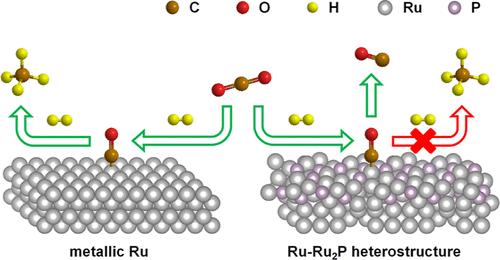精细的 Ru-Ru2P 异质结构可实现高活性、高选择性的 CO2 加氢转化为 CO
IF 11.3
1区 化学
Q1 CHEMISTRY, PHYSICAL
引用次数: 0
摘要
反向水气变换(RWGS)反应是一种前景广阔的二氧化碳利用途径,但发现最佳活性物种仍是一项重大挑战。在这里,我们制备了一种超小型 Ru-Ru2P 异质结构,其中 Ru 纳米粒子与 Ru2P 纳米粒子紧密接触,并被 Ru2P 物种修饰。通过探索钌磷化物的催化性能,我们发现,由于钌磷化物独特的表面结构阻碍了强键 CO 中间体向 CH4 的深度氢化,因此可以通过二氧化硅支撑的 Ru 催化剂的磷化作用将 CO2 加氢的产物选择性从 CH4 完全调整为 CO。与纯 Ru2P 和 RuP 相比,Ru-Ru2P 异质结构的催化活性更强,这是因为它具有更强的吸附和活化 CO2 和 H2 的能力。经过 100 小时的高温反应后,Ru-Ru2P 异质结构保持稳定,CO 生成率几乎不变,CO 选择性达到 100%。此外,原位漫反射红外傅立叶变换光谱研究揭示了磷化钌上的 RWGS 反应是通过氧化还原机制进行的。我们的工作表明,Ru-Ru2P 异质结构是具有高活性和 CO 选择性的优化活性物种,并强调了在催化 CO2 加氢过程中,CO 中间加氢的惰性催化活性在决定 CO 选择性方面比一般认为的弱 CO 吸附性起着更关键的作用。本文章由计算机程序翻译,如有差异,请以英文原文为准。

Fine Ru-Ru2P Heterostructure Enables Highly Active and Selective CO2 Hydrogenation to CO
The reverse water–gas shift (RWGS) reaction is a promising pathway for CO2 utilization, while discovering optimal active species remains a significant challenge. Here we fabricated an ultrasmall Ru-Ru2P heterostructure, in which the Ru nanoparticle is in close contact with the Ru2P nanoparticle and modified by Ru2P species. Through exploring the catalytic performance of ruthenium phosphides, we found that the product selectivity for CO2 hydrogenation can be completely tuned from CH4 to CO through phosphidation of a SiO2-supported Ru catalyst because the distinctive surface structure of ruthenium phosphides interdicts the deep hydrogenation of the strongly bonded CO intermediate to CH4. Enhanced catalytic activity is achieved on the Ru-Ru2P heterostructure compared to pure Ru2P and RuP owing to its stronger capability to adsorb and activate CO2 and H2. Following a 100 h high-temperature reaction, the Ru-Ru2P heterostructure remained stable with a nearly constant CO production rate and 100% CO selectivity. Furthermore, an in situ diffuse reflectance infrared Fourier transform spectroscopy study unveils that the RWGS reaction on the ruthenium phosphides proceeds through the redox mechanism. Our work demonstrates that the Ru-Ru2P heterostructure acts as the optimized active species with high activity and CO selectivity and highlights that the inert catalytic activity for CO intermediate hydrogenation plays a more crucial role in determining CO selectivity in catalytic CO2 hydrogenation than the generally considered weak CO adsorption.
求助全文
通过发布文献求助,成功后即可免费获取论文全文。
去求助
来源期刊

ACS Catalysis
CHEMISTRY, PHYSICAL-
CiteScore
20.80
自引率
6.20%
发文量
1253
审稿时长
1.5 months
期刊介绍:
ACS Catalysis is an esteemed journal that publishes original research in the fields of heterogeneous catalysis, molecular catalysis, and biocatalysis. It offers broad coverage across diverse areas such as life sciences, organometallics and synthesis, photochemistry and electrochemistry, drug discovery and synthesis, materials science, environmental protection, polymer discovery and synthesis, and energy and fuels.
The scope of the journal is to showcase innovative work in various aspects of catalysis. This includes new reactions and novel synthetic approaches utilizing known catalysts, the discovery or modification of new catalysts, elucidation of catalytic mechanisms through cutting-edge investigations, practical enhancements of existing processes, as well as conceptual advances in the field. Contributions to ACS Catalysis can encompass both experimental and theoretical research focused on catalytic molecules, macromolecules, and materials that exhibit catalytic turnover.
 求助内容:
求助内容: 应助结果提醒方式:
应助结果提醒方式:


